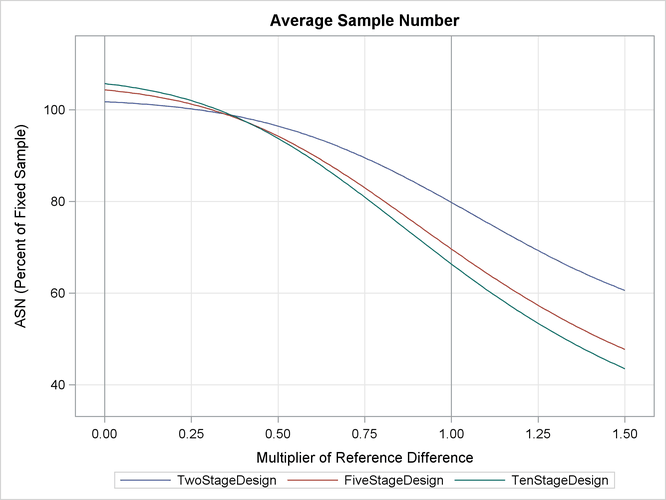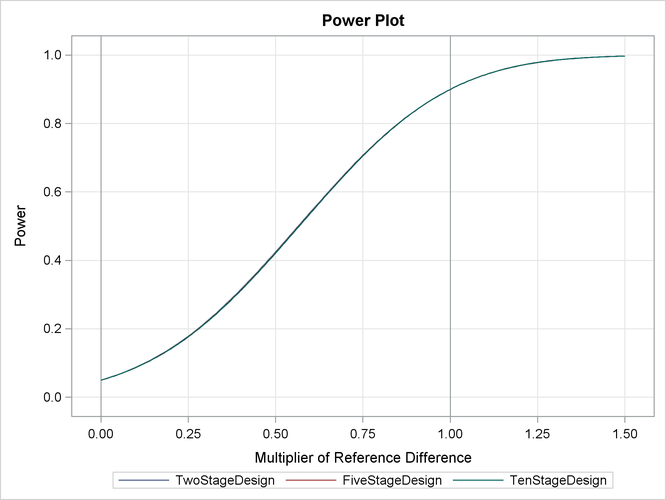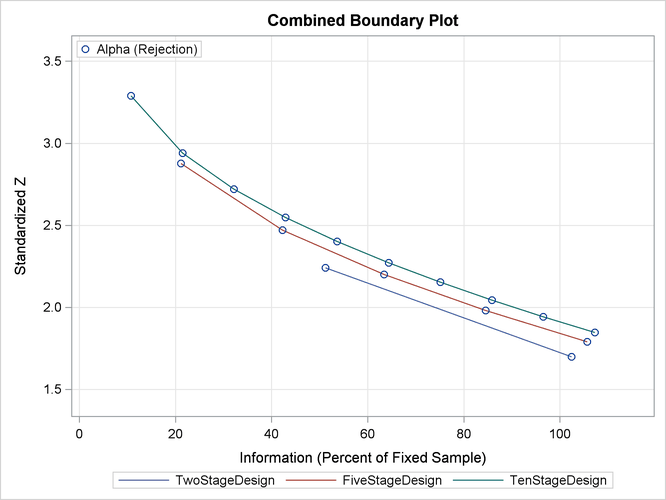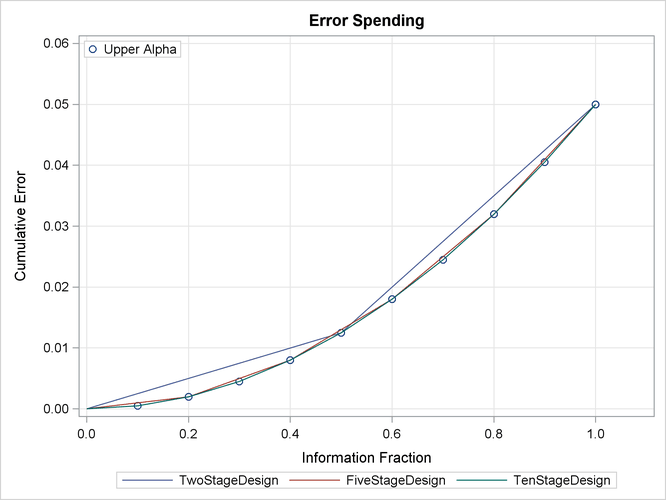The SEQDESIGN Procedure
-
Overview

- Getting Started
-
Syntax

-
Details
 Fixed-Sample Clinical TrialsOne-Sided Fixed-Sample Tests in Clinical TrialsTwo-Sided Fixed-Sample Tests in Clinical TrialsGroup Sequential MethodsStatistical Assumptions for Group Sequential DesignsBoundary ScalesBoundary VariablesType I and Type II ErrorsUnified Family MethodsHaybittle-Peto MethodWhitehead MethodsError Spending MethodsAcceptance (beta) BoundaryBoundary Adjustments for Overlapping Lower and Upper beta BoundariesSpecified and Derived ParametersApplicable Boundary KeysSample Size ComputationApplicable One-Sample Tests and Sample Size ComputationApplicable Two-Sample Tests and Sample Size ComputationApplicable Regression Parameter Tests and Sample Size ComputationAspects of Group Sequential DesignsSummary of Methods in Group Sequential DesignsTable OutputODS Table NamesGraphics OutputODS Graphics
Fixed-Sample Clinical TrialsOne-Sided Fixed-Sample Tests in Clinical TrialsTwo-Sided Fixed-Sample Tests in Clinical TrialsGroup Sequential MethodsStatistical Assumptions for Group Sequential DesignsBoundary ScalesBoundary VariablesType I and Type II ErrorsUnified Family MethodsHaybittle-Peto MethodWhitehead MethodsError Spending MethodsAcceptance (beta) BoundaryBoundary Adjustments for Overlapping Lower and Upper beta BoundariesSpecified and Derived ParametersApplicable Boundary KeysSample Size ComputationApplicable One-Sample Tests and Sample Size ComputationApplicable Two-Sample Tests and Sample Size ComputationApplicable Regression Parameter Tests and Sample Size ComputationAspects of Group Sequential DesignsSummary of Methods in Group Sequential DesignsTable OutputODS Table NamesGraphics OutputODS Graphics -
Examples
 Creating Fixed-Sample DesignsCreating a One-Sided O’Brien-Fleming DesignCreating Two-Sided Pocock and O’Brien-Fleming DesignsGenerating Graphics Display for Sequential DesignsCreating Designs Using Haybittle-Peto MethodsCreating Designs with Various Stopping CriteriaCreating Whitehead’s Triangular DesignsCreating a One-Sided Error Spending DesignCreating Designs with Various Number of StagesCreating Two-Sided Error Spending Designs with and without Overlapping Lower and Upper beta BoundariesCreating a Two-Sided Asymmetric Error Spending Design with Early Stopping to Reject H0Creating a Two-Sided Asymmetric Error Spending Design with Early Stopping to Reject or Accept H0Creating a Design with a Nonbinding Beta BoundaryComputing Sample Size for Survival Data
Creating Fixed-Sample DesignsCreating a One-Sided O’Brien-Fleming DesignCreating Two-Sided Pocock and O’Brien-Fleming DesignsGenerating Graphics Display for Sequential DesignsCreating Designs Using Haybittle-Peto MethodsCreating Designs with Various Stopping CriteriaCreating Whitehead’s Triangular DesignsCreating a One-Sided Error Spending DesignCreating Designs with Various Number of StagesCreating Two-Sided Error Spending Designs with and without Overlapping Lower and Upper beta BoundariesCreating a Two-Sided Asymmetric Error Spending Design with Early Stopping to Reject H0Creating a Two-Sided Asymmetric Error Spending Design with Early Stopping to Reject or Accept H0Creating a Design with a Nonbinding Beta BoundaryComputing Sample Size for Survival Data - References
Example 83.9 Creating Designs with Various Number of Stages
This example requests three group sequential designs for normally distributed statistics. Each design uses the power family
error spending function with the default power parameter ![]() . The specified error spending method is between the approximated Pocock method (
. The specified error spending method is between the approximated Pocock method (![]() ) and the approximated O’Brien-Fleming method (
) and the approximated O’Brien-Fleming method (![]() ) (Jennison and Turnbull, 2000, p. 148). The three designs are identical except for the specified number of stages. The following statements request these
three group sequential designs:
) (Jennison and Turnbull, 2000, p. 148). The three designs are identical except for the specified number of stages. The following statements request these
three group sequential designs:
ods graphics on;
proc seqdesign plots=( asn
power
combinedboundary
errspend(hscale=info)
)
;
TwoStageDesign: design nstages=2
method=errfuncpow
alt=upper stop=reject
;
FiveStageDesign: design nstages=5
method=errfuncpow
alt=upper stop=reject
;
TenStageDesign: design nstages=10
method=errfuncpow
alt=upper stop=reject
;
run;
ods graphics off;
The “Design Information” table in Output 83.9.1 displays design information for the two-stage design.
Output 83.9.1: Design Information
| Design Information | |
|---|---|
| Statistic Distribution | Normal |
| Boundary Scale | Standardized Z |
| Alternative Hypothesis | Upper |
| Early Stop | Reject Null |
| Method | Error Spending |
| Boundary Key | Both |
| Number of Stages | 2 |
| Alpha | 0.05 |
| Beta | 0.1 |
| Power | 0.9 |
| Max Information (Percent of Fixed Sample) | 102.4167 |
| Null Ref ASN (Percent of Fixed Sample) | 101.7766 |
| Alt Ref ASN (Percent of Fixed Sample) | 79.81021 |
The “Boundary Information” table in Output 83.9.2 displays the information level, alternative reference, and boundary values. By default (or equivalently if you specify BOUNDARYSCALE=STDZ),
the alternative reference and boundary values are displayed with the standardized normal Z scale. The resulting standardized alternative reference at stage k is given by ![]() , where
, where ![]() is the alternative reference and
is the alternative reference and ![]() is the information level at stage k,
is the information level at stage k, ![]() .
.
Output 83.9.2: Boundary Information in ![]() Scale
Scale
| Boundary Information (Standardized Z Scale) Null Reference = 0 |
|||
|---|---|---|---|
| _Stage_ | Information Level |
Alternative | Boundary Values |
| Reference | Upper | ||
| Proportion | Upper | Alpha | |
| 1 | 0.5000 | 2.09414 | 2.24140 |
| 2 | 1.0000 | 2.96156 | 1.69970 |
The “Design Information” table in Output 83.9.3 displays design information for the five-stage design. Compared with the two-stage design in Output 83.9.1, the maximum information increases from 102.42 to 105.62, and the average sample number under the alternative reference (Alt Ref ASN) decreases from 79.81 to 69.64.
Output 83.9.3: Design Information
| Design Information | |
|---|---|
| Statistic Distribution | Normal |
| Boundary Scale | Standardized Z |
| Alternative Hypothesis | Upper |
| Early Stop | Reject Null |
| Method | Error Spending |
| Boundary Key | Both |
| Number of Stages | 5 |
| Alpha | 0.05 |
| Beta | 0.1 |
| Power | 0.9 |
| Max Information (Percent of Fixed Sample) | 105.6235 |
| Null Ref ASN (Percent of Fixed Sample) | 104.356 |
| Alt Ref ASN (Percent of Fixed Sample) | 69.64322 |
The “Boundary Information” table in Output 83.9.4 displays the information level, alternative reference, and boundary values with the default standardized normal Z scale.
Output 83.9.4: Boundary Information in ![]() Scale
Scale
| Boundary Information (Standardized Z Scale) Null Reference = 0 |
|||
|---|---|---|---|
| _Stage_ | Information Level |
Alternative | Boundary Values |
| Reference | Upper | ||
| Proportion | Upper | Alpha | |
| 1 | 0.2000 | 1.34502 | 2.87816 |
| 2 | 0.4000 | 1.90215 | 2.47023 |
| 3 | 0.6000 | 2.32965 | 2.20095 |
| 4 | 0.8000 | 2.69005 | 1.98182 |
| 5 | 1.0000 | 3.00756 | 1.79024 |
The “Design Information” table in Output 83.9.5 displays design information for the ten-stage design. Compared with the five-stage design in Output 83.9.3, the maximum information increases further from 105.62 to 107.26 and under the alternative reference, the average sample number decreases further from 69.64 to 66.36.
Output 83.9.5: Design Information
| Design Information | |
|---|---|
| Statistic Distribution | Normal |
| Boundary Scale | Standardized Z |
| Alternative Hypothesis | Upper |
| Early Stop | Reject Null |
| Method | Error Spending |
| Boundary Key | Both |
| Number of Stages | 10 |
| Alpha | 0.05 |
| Beta | 0.1 |
| Power | 0.9 |
| Max Information (Percent of Fixed Sample) | 107.256 |
| Null Ref ASN (Percent of Fixed Sample) | 105.7276 |
| Alt Ref ASN (Percent of Fixed Sample) | 66.35565 |
The “Boundary Information” table in Output 83.9.6 displays the information level, alternative reference, and boundary values with the default standardized normal Z scale.
Output 83.9.6: Boundary Information in ![]() Scale
Scale
| Boundary Information (Standardized Z Scale) Null Reference = 0 |
|||
|---|---|---|---|
| _Stage_ | Information Level |
Alternative | Boundary Values |
| Reference | Upper | ||
| Proportion | Upper | Alpha | |
| 1 | 0.1000 | 0.95840 | 3.29053 |
| 2 | 0.2000 | 1.35538 | 2.94037 |
| 3 | 0.3000 | 1.65999 | 2.72115 |
| 4 | 0.4000 | 1.91679 | 2.54808 |
| 5 | 0.5000 | 2.14304 | 2.40114 |
| 6 | 0.6000 | 2.34758 | 2.27127 |
| 7 | 0.7000 | 2.53568 | 2.15359 |
| 8 | 0.8000 | 2.71076 | 2.04503 |
| 9 | 0.9000 | 2.87519 | 1.94355 |
| 10 | 1.0000 | 3.03072 | 1.84765 |
With the PLOTS=ASN option, the procedure displays a plot of average sample numbers under various hypothetical references for
all designs simultaneously, as shown in Output 83.9.7. By default, the option CREF= ![]() and expected sample sizes under the hypothetical references
and expected sample sizes under the hypothetical references ![]() are displayed, where
are displayed, where ![]() are values specified in the CREF= option. These CREF= values are displayed on the horizontal axis.
are values specified in the CREF= option. These CREF= values are displayed on the horizontal axis.
Output 83.9.7: ASN Plot

The plot shows that as the number of stages increases, the average sample number as a percentage of the fixed-sample design
increases under the null hypothesis (![]() ) but decreases under the alternative hypothesis (
) but decreases under the alternative hypothesis (![]() ).
).
With the PLOTS=POWER option, the procedure displays a plot of the power curves under various hypothetical references for all
designs simultaneously, as shown in Output 83.9.8. By default, the option CREF= ![]() and powers under hypothetical references
and powers under hypothetical references ![]() are displayed, where
are displayed, where ![]() are values specified in the CREF= option. These CREF= values are displayed on the horizontal axis.
are values specified in the CREF= option. These CREF= values are displayed on the horizontal axis.
Output 83.9.8: Power Plot

Under the null hypothesis, ![]() , the power is 0.05, the upper Type I error probability. Under the alternative hypothesis,
, the power is 0.05, the upper Type I error probability. Under the alternative hypothesis, ![]() , the power is 0.9, one minus the Type II error probability. The plot shows only minor difference among the three designs.
, the power is 0.9, one minus the Type II error probability. The plot shows only minor difference among the three designs.
With the PLOTS=COMBINEDBOUNDARY option, the procedure displays a plot of sequential boundaries for all designs simultaneously, as shown in Output 83.9.9. By default (or equivalently if you specify COMBINEDBOUNDARY(HSCALE=INFO)), the information levels are used on the horizontal axis. Since the maximum information is not available for the design, the percent information ratios with respect to the corresponding fixed-sample design are displayed in the plot.
Output 83.9.9: Combined Boundary Plot

The plot shows that as the number of stages increases, the maximum information increases and the ![]() boundary values also increase.
boundary values also increase.
With the PLOTS=ERRSPEND(HSCALE=INFO) option, the procedure displays a plot of cumulative error spends for all boundaries in the designs simultaneously, as shown in Output 83.9.10.
Output 83.9.10: Error Spending Plot

The plot shows similar error spending for these three designs since all three designs are generated from the same power family error spending function.